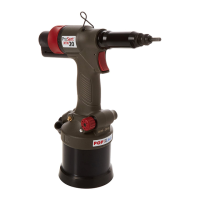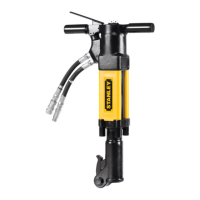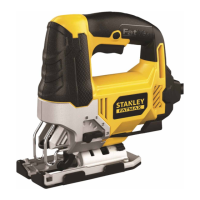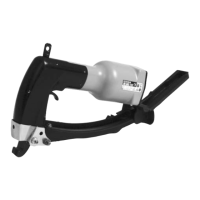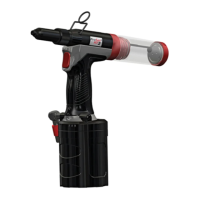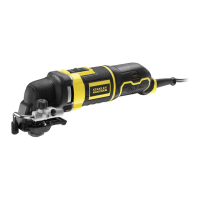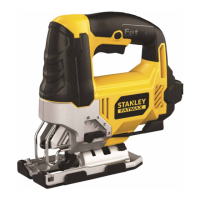ENGLISH
6
• Be aware that failure of the workpiece or accessories, or even of the inserted tool itself can generate
highvelocity projectiles.
• Always wear impact-resistant eye protection during operation of the tool. The grade of protection required
should be assessed for each use.
• The risks to others should also be assessed at this time.
• Ensure that the workpiece is securely xed.
• Check that the means of protection from ejection of fastener and/or mandrel is in place and is operative.
• DO NOT use the tool without mandrel collector installed.
• Warn against the possible forcible ejection of mandrels from the front of the tool.
• DO NOT operate a tool that is directed towards any person(s).
1.3 OPERATING HAZARDS
• Use of the tool can expose the operator’s hands to hazards, including crushing, impacts, cuts and abrasions
and heat. Wear suitable gloves to protect hands.
• Operators and maintenance personnel shall be physically able to handle the bulk, weight and power of the
tool.
• Hold the tool correctly; be ready to counteract normal or sudden movements and have both hands
available.
• Keep tool handles dry, clean, and free from oil and grease.
• Maintain a balanced body position and secure footing when operating the tool.
• Release the start-and-stop device in the case of an interruption of the air supply.
• Use only lubricants recommended by the manufacturer.
• Contact with hydraulic uid should be avoided. To minimise the possibility of rashes, care should be taken
to wash thoroughly if contact occurs.
• Material Safety Data Sheets for all hydraulic oils and lubricants is available on request from your tool
supplier.
• Avoid unsuitable postures as it is likely for these positions not to allow counteracting of normal or
unexpected movement of the tool.
• If the tool is xed to a suspension device, make sure that the xation is secure.
• Beware of the risk of crushing or pinching if nose equipment is not tted.
• DO NOT operate tool with the nose casing removed.
• Adequate clearance is required for the tool operator’s hands before proceeding.
• When carrying the tool from place to place keep hands away from the trigger to avoid inadvertent activation.
• DO NOT abuse the tool by dropping or using it as a hammer.
• Care should be taken to ensure that spent mandrels do not create a hazard.
• The mandrel collector must be emptied when approximately half full.
1.4 REPETITIVE MOTIONS HAZARDS
• When using the tool, the operator can experience discomfort in the hands, arms, shoulders, neck or other
parts of the body.
• While using the tool, the operator should adopt a comfortable posture whilst maintaining a secure footing
and avoiding awkward or o -balance postures. The operator should change posture during extended
tasks; this can help avoid discomfort and fatigue.
• If the operator experiences symptoms such as persistent or recurring discomfort, pain, throbbing, aching,
tingling, numbness, burning sensations or sti ness, these warning signs should not be ignored. The
operator should tell the employer and consult a quali ed health professional.
1.5 ACCESSORY HAZARDS
• Disconnect the tool from the air supply before tting or removing the nose assembly or accessory.
• Use only sizes and types of accessories and consumables that are recommended by the manufacturer of
the tool; do not use other types or sizes of accessories or consumables.
1.6 WORKPLACE HAZARDS
• Slips, trips and falls are major causes of workplace injury. Be aware of slippery surfaces caused by use of the
tool and also of trip hazards caused by the air line or hydraulic hose.

